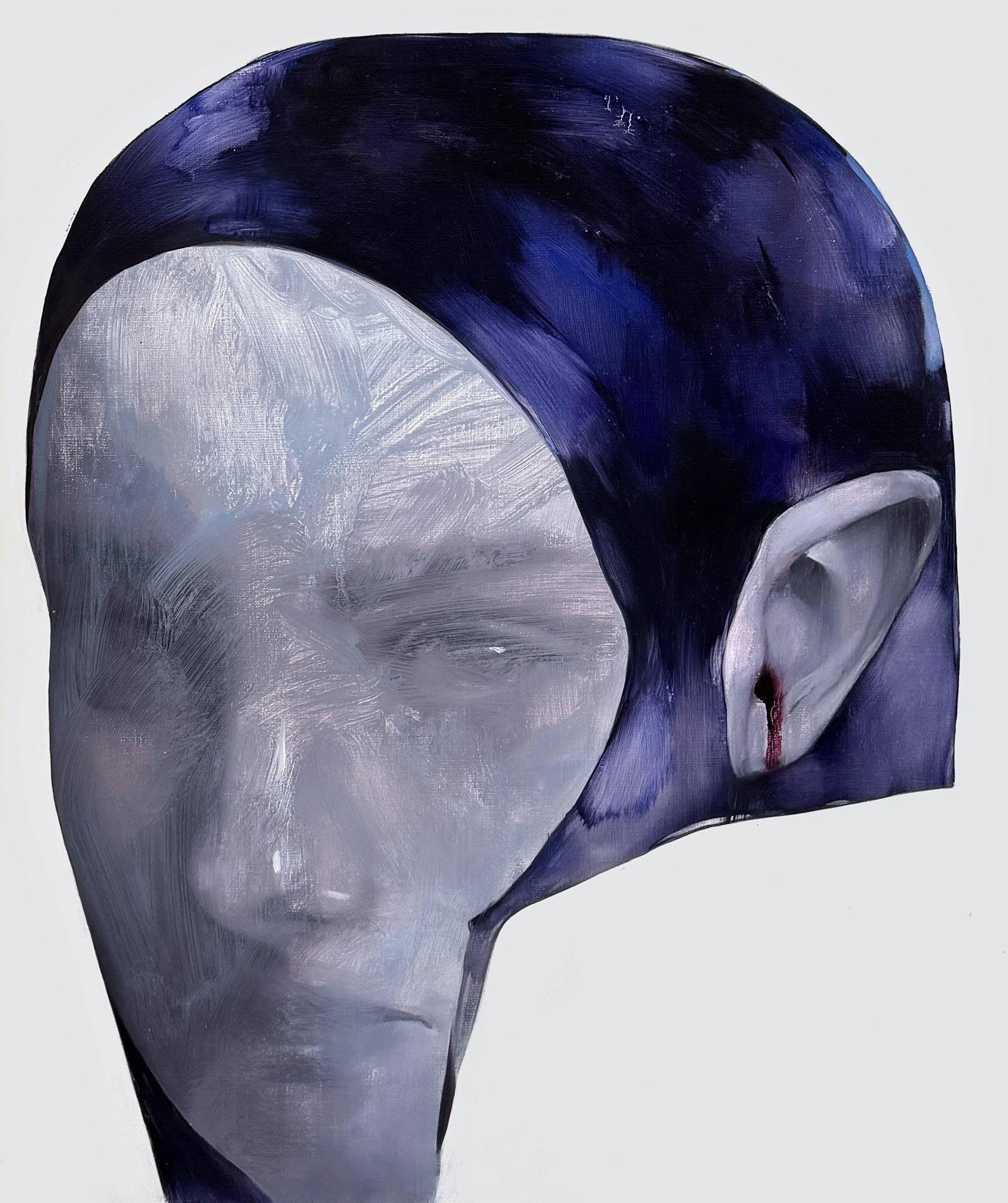Kateryna Reznichenko: MOrphosis
May 3–31, 2025
In Morphosis, Kateryna Reznichenko delicately balances between the clean geometry of rendered faces and a wild, uncontrolled bloom of paint: her figures appear mid-transformation, not yet resolved or fully formed. They hover in the liminal, half-birth, half-erasure, perhaps haunted by what they once were and trembling with what they might become.
There is an ongoing dialogue between discipline and chaos throughout this body of work. Reznichenko knows her edges, but she also knows how to let them go. Her brushwork is not reckless, but it listens and waits. She invites the materials into the conversation, and in doing so, she relinquishes authorship just enough to invite mystery in.
Is it a diaphanous burst of ultramarine that becomes the painting’s gravitational center; or is the face itself? The tension between this duality is ongoing, intention and accident locked in a quiet, intimate duel. These are works that don’t ask to be solved; they ask to be sat with, like grief, or love, or the unnamable things that move through us when we change.
The titles—Jellyfish, Totem, Medusa—point us toward myth and nature. Reznichenko leans into archetypes without falling into cliché. Her Medusa does not hiss; she contemplates. Her Bird does not fly; it watches. And in Athena, named for the goddess of wisdom and war, we see a softness, not armor. Even divinity, it seems, is porous. These figures are not symbols to be read, but living things to be encountered. They are masks, but masks in the process of dissolving.
What Reznichenko achieves in this body of work is not only aesthetic tension, it is existential. These paintings examine the shapeshifting nature of the self, and are an invitation to observe long enough to feel that shift within ourselves. Morphosis is not only what we see occurring with the subjects—it is also what happens to us, the viewer, in the act of witnessing. We are confronted with the question of what we must allow to dissolve so that something new, something truer, might emerge.
KATERYNA REZNICHENKO
ATHENAOil and acrylic on canvas24 x 20 inches / 61 x 50.8 centimeters
$1500INQUIRE →
KATERYNA REZNICHENKO
BIRDOil and acrylic on canvas20 x 16 inches / 50.8 x 40.6 centimeters
$1300INQUIRE →
KATERYNA REZNICHENKO
JELLYFISHOil and acrylic on canvas24 x 20 inches / 61 x 50.8 centimeters
$1500INQUIRE →
KATERYNA REZNICHENKO
FISHOil and acrylic on canvas24 x 20 inches / 61 x 50.8 centimeters
$1500INQUIRE →
KATERYNA REZNICHENKO
JELLYFISHOil and acrylic on canvas24 x 20 inches / 61 x 50.8 centimeters
ON HOLD
KATERYNA REZNICHENKO
BREATHOil and acrylic on canvas24 x 20 inches / 61 x 50.8 centimeters
$1500INQUIRE →
KATERYNA REZNICHENKO
TOTEMOil and acrylic on canvas30 x 24 inches / 76.2 x 61 centimeters
$1600INQUIRE →
KATERYNA REZNICHENKO
MEDUSAOil and acrylic on canvas60 x 36 inches / 152.4 x 91.4 centimeters
$7400INQUIRE →
KATERYNA REZNICHENKO
TOTEMOil and acrylic on canvas30 x 24 inches / 76.2 x 61 centimeters
$1600INQUIRE →
KATERYNA REZNICHENKO
FOCUSOil and acrylic on canvas24 x 20 inches / 61 x 50.8 centimeters
SOLD
KATERYNA REZNICHENKO
ROBEOil and acrylic on canvas24 x 40 inches / 61 x 101.6 centimeters
$3000INQUIRE →
KATERYNA REZNICHENKO
TOTEMOil and acrylic on canvas40 x 30 inches / 101.6 x 76.2 centimeters
$2700INQUIRE →
KATERYNA REZNICHENKO
NOISEOil and acrylic on canvas24 x 20 inches / 61 x 50.8 centimeters
SOLD
Kateryna Reznichenko (b. 1997) is a Ukrainian artist from Lviv, currently living and working in Seattle, USA. Reznichenko honed her skills at the Ivan Trush Lviv College and holds a Master’s degree from the Lviv National Academy of Arts monumental art department.
For Reznichenko, art is a language—an alternative way to reflect, record, and communicate without using words. Her paintings inhabit a space between clarity and collapse.
She is drawn to the tension between control and spontaneity. Reznichenko combines carefully rendered, realistic elements with expressive, fluid gestures—stains, textures, and marks that emerge unpredictably. She allows the material to speak, inviting chance to intervene.
Often, a single spontaneous form becomes a turning point in the composition—a moment where intention meets accident.
Themes of transformation and resistance run throughout her practice. She does not seek to capture a likeness, but rather a state of becoming.













